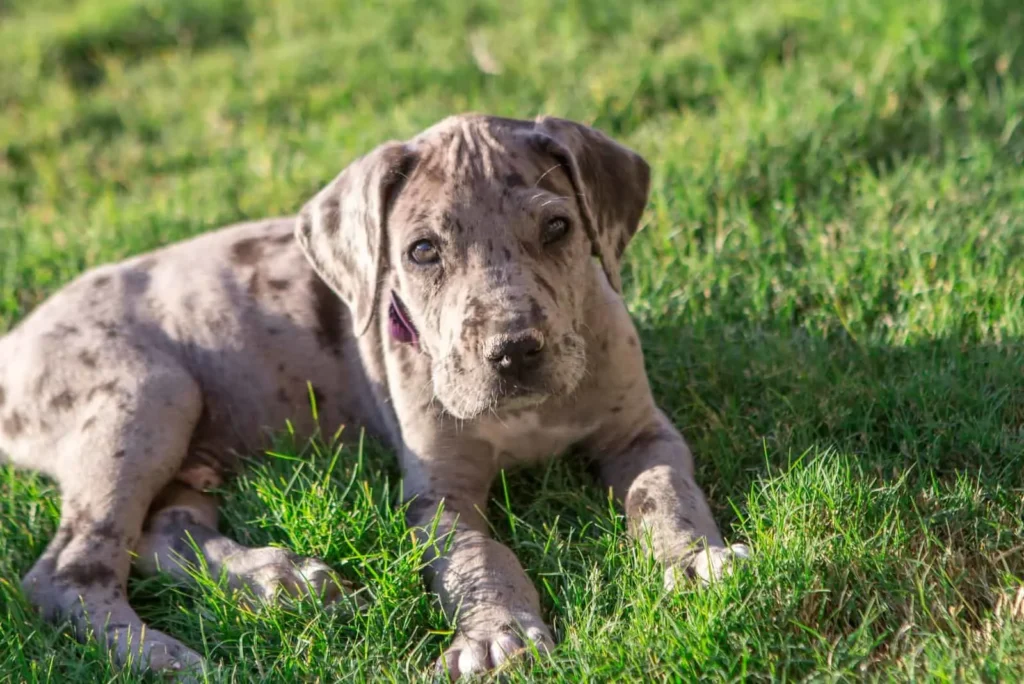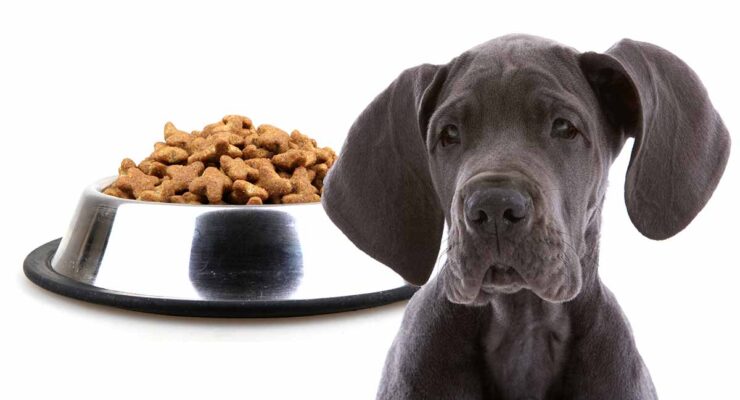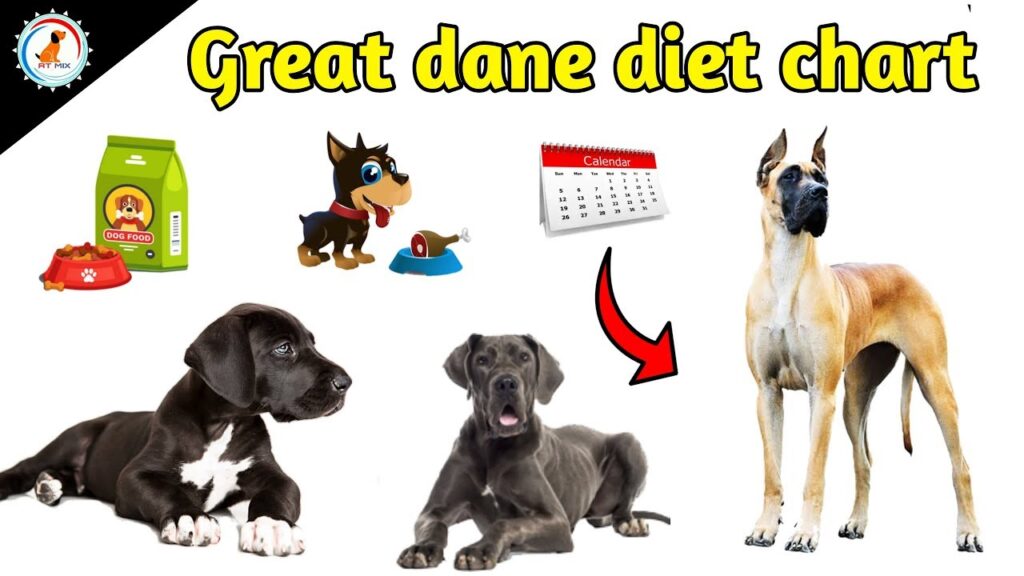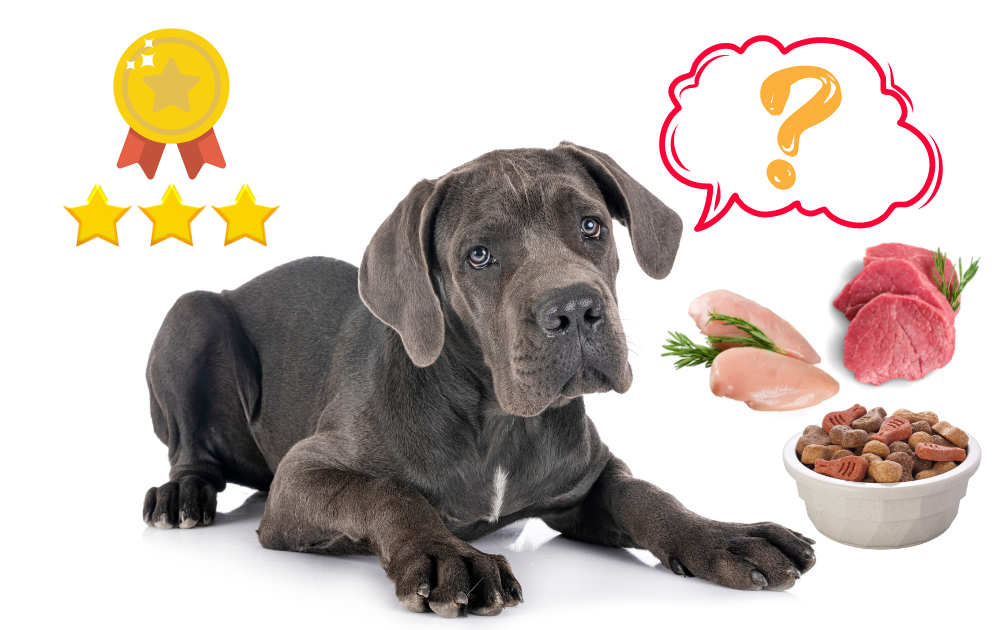Feeding Great Dane puppies requires a strategic approach to help these majestic dogs grow into healthy, robust adults. As one of the most iconic large dog breeds, Great Danes need specialized diets to support rapid growth, strong bones, and vibrant health. Without proper nutrition, these gentle giants can face serious issues like joint problems or obesity.
In this guide, you’ll learn how to feed a Great Dane puppy properly, including practical tips, recommended food choices, and essential care advice. Whether you’re a first-time pet parent or adjusting your feeding plan, this resource offers everything you need for optimal Great Dane puppy nutrition.
Why Proper Nutrition Matters for Great Dane Puppies
Supporting Rapid Growth and Development
During their first year, Great Dane puppies can reach up to 100 pounds, making nutrition a critical part of their development. Pet parents must prioritize balanced meals rich in protein, calcium, and other key nutrients. A well-planned diet strengthens bones, supports muscle growth, and boosts immunity.
For example, providing a large-breed-specific formula can help prevent conditions like hip dysplasia, which often result from nutritional imbalances. Overfeeding or offering food with incorrect nutrient ratios may lead to obesity or joint stress—issues that hinder proper Great Dane puppy growth.
That’s why many caregivers focus on structured feeding schedules and breed-appropriate food to support healthy development and long-term vitality.
Preventing Health Issues Through Diet
Diet also plays a key role in preventing common health issues in Great Dane puppies, especially bloat (gastric dilatation-volvulus) and joint complications. Feeding smaller, controlled portions throughout the day reduces the risk of bloat—a potentially fatal condition.
Additionally, selecting dog food with joint-supporting ingredients such as glucosamine and chondroitin helps maintain joint mobility and overall comfort. By prioritizing nutritional quality, pet parents enhance both the health and quality of life of their Great Dane puppies.

Nutritional Requirements for Great Dane Puppies
Essential Nutrients for Growth
Great Dane puppies need targeted nutrition to match their unique growth pattern. Here’s what to look for in their diet:
- Protein: Choose high-quality sources like chicken or lamb, with 22–26% protein content, to support lean muscle development.
- Calcium and Phosphorus: Maintain calcium levels between 1 and 1.5% and phosphorus between 0.8 and 1.2% to ensure proper bone growth without overdevelopment.
- Fats: Include 12–16% healthy fats to supply energy and support coat health.
- Vitamins and Minerals: Ensure the diet is rich in vitamins A, D, and E, as well as zinc, to strengthen immunity and promote healthy skin and coat.
Always choose food specifically formulated for large-breed puppies. These formulas ensure nutrient ratios are balanced to meet the breed’s rapid developmental needs.
Caloric Needs and Portion Control
Great Dane puppies typically require 25–50 calories per pound of body weight per day, depending on age and activity level. For example, a 3-month-old puppy weighing 30 pounds may need between 750 and 1,500 calories daily.
To support digestion and reduce the risk of bloat, divide their daily intake into 3–4 meals. Carefully monitoring portion sizes helps prevent overfeeding, which can cause rapid weight gain and joint strain. By staying consistent and attentive, caregivers can manage growth responsibly and reduce long-term health risks.
Great Dane Puppy Feeding Guide: Sample Meal Plans
Feeding Great Dane puppies properly supports their rapid growth and helps prevent long-term health issues. A structured Great Dane puppy feeding guide ensures each meal contributes to muscle development, bone strength, and overall vitality. For instance, a 3-month-old Great Dane puppy weighing around 30 pounds typically needs 3–4 cups of large-breed puppy food daily, split into four meals. By six months, a 60-pound puppy may require 5–6 cups across three feedings, depending on activity levels.
Sample Daily Feeding Schedule for Great Dane Puppies
A consistent schedule supports digestion and helps prevent bloat—a common risk in large breeds:
- 7:00 AM: 1 cup kibble mixed with wet food for added hydration
- 12:00 PM: 1 cup kibble with fish oil for joint support
- 5:00 PM: 1 cup kibble with a glucosamine supplement
- 9:00 PM: ½ cup kibble for younger puppies (optional based on age)
By following a tailored Great Dane puppy meal plan, caregivers promote healthy growth, maintain energy levels, and ensure proper nutrient intake. Structured mealtimes also reduce the risk of overeating and digestive stress.
Choosing the Best Food for Great Dane Puppies
Selecting the best food for Great Dane puppies plays a vital role in their early development and long-term health. Since these gentle giants grow rapidly, they require a carefully balanced diet to support controlled growth. Ideally, caregivers should choose high-quality commercial foods specifically labeled for large-breed puppies, such as Orijen Large Breed Puppy or Hill’s Science Diet Puppy Large Breed. These brands balance protein, fat, and calcium to promote strong bone and muscle development without encouraging excessive growth.
In addition, caregivers should check the ingredient list for whole protein sources like chicken, lamb, or fish as the first ingredient, avoiding fillers like corn, wheat, or meat by-products. Prioritizing digestible ingredients and essential nutrients helps meet Great Dane puppy food recommendations.
Moreover, for those considering budget-friendly or homemade diet plans, consulting with a veterinarian or canine nutritionist is essential. A vet can help ensure the recipe meets all nutritional requirements, including proper calcium-to-phosphorus ratios and vitamins. Homemade diets require extra caution to avoid imbalances that can harm a growing puppy.
For optimal nutrition, caregivers should look for foods containing 22–26% protein and 12–16% fat, which align with Great Dane puppy nutritional needs. By making informed choices, caregivers can support the healthy development of their pups while meeting the dietary needs of large breeds.
Feeding Great Dane Puppies for Weight Management
Managing a Great Dane puppy’s weight is just as crucial as choosing the right food. Overfeeding or feeding inappropriate diets can lead to obesity, which increases the risk of serious health problems like hip dysplasia and heart strain. That’s why caregivers must feed intentionally and keep a close eye on weekly weight gain.
Ideally, Great Dane puppies should gain 1 to 2 pounds per week during their rapid growth phase. To achieve this, caregivers should measure food portions precisely using standard measuring cups or a digital scale. Overfeeding, even unintentionally, can quickly lead to joint stress.
Incorporating moderate daily exercise also helps manage weight without overstraining growing joints. Short, gentle walks or supervised play in a safe space promote healthy calorie burn. Furthermore, choosing foods with lean protein and adequate fiber helps maintain proper weight and supports digestion.
By combining portion control, structured feeding, and moderate physical activity, caregivers ensure their Great Dane puppy grows steadily while avoiding weight-related issues.
Common Myths About Feeding Great Dane Puppies
Misinformation about feeding Great Dane puppies can lead to health complications. One of the most common myths is that “puppies can eat adult dog food.” However, adult formulas lack the specific nutrients required for large-breed puppies and can contribute to growth disorders.
Another widespread myth is that “more food means faster, stronger growth.” While it may seem logical, overfeeding increases the risk of skeletal deformities and joint problems, especially during the growth spurt months.
In addition, some caregivers believe that extra calcium supplements boost bone strength. In reality, excess calcium can disrupt the delicate balance needed for proper bone growth, causing joint pain or abnormalities. Unless recommended by a veterinarian, supplements should be avoided.
By understanding and debunking Great Dane puppy feeding myths, caregivers can prevent nutritional mistakes and focus on a balanced, science-backed diet plan.
Feeding Great Dane Puppies with Special Dietary Needs
Some Great Dane puppies have unique dietary challenges, such as food allergies, intolerances, or medical conditions like kidney disease. These issues require tailored diets to maintain health and comfort.
For example, puppies with sensitive stomachs may experience symptoms like itching, diarrhea, or vomiting. In such cases, caregivers should work with a veterinarian to identify allergens and switch to hypoallergenic or limited-ingredient diets, such as those with lamb, salmon, or novel proteins like duck or venison.
Additionally, puppies diagnosed with medical issues like kidney problems may need prescription diets that regulate protein and phosphorus levels. These diets often require strict veterinary supervision to ensure they don’t worsen the condition.
By identifying triggers early and collaborating with professionals, caregivers can provide safe, nourishing diets tailored to their puppy’s specific health needs.

Feeding Schedules for Great Dane Puppies
Age-Based Feeding Frequency
Feeding schedules should evolve as your Great Dane puppy grows. Following an age-appropriate schedule promotes steady growth and prevents digestive issues:
- 2 to 4 Months: Feed 4 meals per day. Frequent meals help with digestion and reduce the risk of bloat.
- 4 to 6 Months: Reduce to 3 meals daily. Puppies still need frequent feeding to meet energy needs.
- 6 to 12 Months: Transition to 2–3 meals per day, depending on the puppy’s appetite and activity level.
Splitting meals throughout the day prevents overeating and supports Great Dane digestive health, especially in the early months.
Timing and Consistency
Establishing a consistent feeding routine is essential for a Great Dane puppy’s well-being. Feeding at scheduled times — for instance, 7 AM, 12 PM, 5 PM, and 9 PM — helps regulate digestion and reduces anxiety. Sticking to a predictable routine also aids in potty training and sleep patterns.
Caregivers should avoid intense exercise for at least 1–2 hours after meals to lower the risk of bloat, a dangerous condition common in deep-chested breeds like Great Danes. Maintaining meal consistency and calm post-meal periods helps protect their delicate digestive systems.
Feeding Great Dane Puppies for Optimal Growth
Balancing Growth and Health
Puppy caregivers balance Great Dane growth carefully to prevent rapid weight gain, which places unnecessary stress on developing joints. They opt for large-breed puppy foods with controlled calcium and phosphorus levels, which help prevent skeletal conditions such as osteochondrosis and panosteitis. During peak growth periods, caregivers aim for a steady gain of 1–2 pounds per week, tracking weight regularly with a scale or vet visits.
Moreover, they avoid underfeeding, which can result in nutrient deficiencies and hinder proper development. To ensure optimal results, caregivers work closely with veterinarians to fine-tune diets. This approach ensures feeding Great Dane puppies for growth, promotes steady development, strong bones, and a healthy metabolism.
Supporting Joint and Bone Health
Great Dane puppy nutrition plays a critical role in developing strong joints and bones. Caregivers prioritize foods rich in glucosamine, chondroitin, and omega-3 fatty acids. These nutrients support cartilage health, reduce the risk of hip dysplasia, and boost joint flexibility.
In addition, fish oil supplements not only support mobility but also enhance skin health and give the puppy a glossy coat. By choosing large-breed-specific formulas, caregivers ensure the diet supports bone development and overall mobility for long-term health.
Feeding Great Dane Puppies with Health Considerations
Preventing Bloat Through Diet
Gastric dilatation-volvulus (bloat) remains a serious risk in Great Dane puppies. To reduce this danger, caregivers feed smaller, more frequent meals throughout the day. They also incorporate slow-feed bowls to prevent fast eating, which reduces air intake and bloating risk.
While some consider elevated food bowls, experts offer mixed opinions. Therefore, many opt for floor-level bowls and focus instead on post-meal rest. Most importantly, they avoid exercise 30–60 minutes after meals. These feeding strategies play a major role in protecting puppies from life-threatening digestive issues.
Addressing Allergies and Sensitivities
Some Great Dane puppies experience food allergies or intolerances, often showing signs like itching, loose stool, or skin inflammation. Puppy parents closely monitor these symptoms and consult with veterinarians to identify specific food triggers.
They typically switch to limited-ingredient diets or hypoallergenic formulas that minimize exposure to common allergens like chicken, wheat, or soy. This proactive approach ensures that feeding Great Dane puppies with sensitivities promotes comfort, better digestion, and consistent weight gain.
Transitioning Great Dane Puppies to Adult Food
As Great Danes reach 18 to 24 months, their growth rate slows, signaling the time to transition to adult food. Puppy parents start the shift by gradually mixing adult formula with their current puppy food over 7 to 10 days, avoiding sudden changes that can cause diarrhea or bloating.
Furthermore, they choose large-breed adult formulas that continue supporting joint health, weight maintenance, and calorie balance. A smooth transition not only protects the digestive system but also reinforces healthy habits into adulthood.
Common Feeding Mistakes to Avoid
To ensure feeding success, caregivers avoid these frequent errors when feeding Great Dane puppies:
- Overfeeding – They measure portions accurately to prevent rapid weight gain and unnecessary joint stress.
- Free-feeding – Rather than leaving food out all day, they stick to a structured feeding schedule.
- Human food – Caregivers avoid giving table scraps, especially toxic foods like chocolate, onions, and grapes.
- Wrong food type – They skip generic or adult dog food in favor of formulas designed for large-breed puppies.
Additionally, they use measuring cups or kitchen scales to control portions precisely. By eliminating these mistakes, caregivers support optimal Great Dane puppy development and long-term health.

Where to Find Healthy Great Dane Puppies for Proper Nutrition
Choosing a Reputable Breeder
To help your future companion enjoy a longer, healthier life, start by choosing a puppy from breeders who prioritize genetics and responsible care. Ethical breeding practices include thorough health screenings and verified clearances for common hereditary conditions.
At Adopt Great Dane, we connect you with exceptional, health-tested Great Dane puppies from champion bloodlines. Each puppy comes from a nurturing, well-maintained environment where socialization and early development are top priorities.
Whether you prefer a fawn, harlequin, brindle, or black coat, our carefully selected puppies are bred for longevity, temperament, and overall well-being. By choosing us, you’re not only adding a magnificent dog to your family—you’re making a lasting investment in a loyal, long-living companion.
Explore our available Great Dane puppies today and take the first step toward a lifetime of companionship.
Frequently Asked Questions About Feeding Great Dane Puppies
How do you feed a Great Dane puppy?
Start by choosing large-breed puppy food with 22–26% protein. Feed your Great Dane puppy 3 to 4 meals daily to ensure steady growth and proper digestion. This routine also helps manage energy levels throughout the day.
What is the best food for Great Dane puppies?
The best option includes high-quality large-breed formulas like Orijen or Wellness Large Breed Puppy. These foods meet Great Dane puppy nutrition needs by supporting balanced development, especially for joints and bones.
What is the ideal feeding schedule for Great Dane puppies?
Follow a consistent feeding schedule based on age:
- 2–4 months: 4 meals per day
- 4–6 months: 3 meals per day
- 6–12 months: 2–3 meals per day
This gradual reduction prevents overeating while still supporting growth.
How much food does a Great Dane puppy need?
Generally, feed your puppy 25–50 calories per pound of body weight daily. Split these calories into 3–4 meals to support healthy digestion and steady weight gain. As your puppy grows, adjust portions accordingly.
Can feeding habits help prevent bloat in Great Danes?
Yes. Serving smaller meals and avoiding exercise for at least an hour after feeding significantly reduces the risk of bloat—a serious health issue for Great Danes. Always use elevated bowls and encourage calm post-meal periods.
Where can you find healthy Great Dane puppies for proper nutrition?
You can find healthy, well-bred Great Dane puppies on our online store. We ensure each puppy receives the right start with appropriate nutrition and care tailored to large breeds.
Final Thoughts
Feeding your Great Dane puppy the right way builds the foundation for a healthy, active life. By choosing the proper food, following a structured feeding schedule, and taking preventive steps against bloat, you set your gentle giant up for success. Ready to welcome a strong and healthy Great Dane into your home? Visit us today and adopt your next loyal companion!

